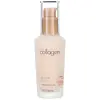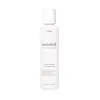What's inside
What's inside
 Key Ingredients
Key Ingredients

 Benefits
Benefits

 Concerns
Concerns

No concerns
 Ingredients Side-by-side
Ingredients Side-by-side

Water
Skin ConditioningHydrolyzed Collagen
EmollientGlycereth-26
HumectantButylene Glycol
HumectantCyclomethicone
EmollientButylene Glycol Dicaprylate/Dicaprate
EmollientMangifera Indica Seed Butter
Skin ConditioningPEG-32
HumectantGlyceryl Polyacrylate
Ethoxydiglycol
HumectantPEG-20 Methyl Glucose Sesquistearate
EmulsifyingLaminaria Japonica Extract
Skin ProtectingCetyl Alcohol
EmollientPolysorbate 60
EmulsifyingPolyacrylate-13
Sorbitan Oleate
EmulsifyingCaprylyl Glycol
EmollientPolyisobutene
Parfum
MaskingMethyl Glucose Sesquistearate
EmollientGlycerin
HumectantEthylhexylglycerin
Skin ConditioningDimethicone
EmollientHydrolyzed Malt Extract
Skin ConditioningSaussurea Involucrata Extract
HumectantTocopheryl Acetate
AntioxidantPanthenol
Skin ConditioningStearic Acid
CleansingPolysorbate 20
EmulsifyingArctostaphylos Uva Ursi Leaf Extract
Skin ConditioningCarbomer
Emulsion StabilisingTriethanolamine
BufferingXanthan Gum
EmulsifyingBHT
AntioxidantDisodium EDTA
CI 15985
Cosmetic ColorantCI 14700
Cosmetic ColorantWater, Hydrolyzed Collagen, Glycereth-26, Butylene Glycol, Cyclomethicone, Butylene Glycol Dicaprylate/Dicaprate, Mangifera Indica Seed Butter, PEG-32, Glyceryl Polyacrylate, Ethoxydiglycol, PEG-20 Methyl Glucose Sesquistearate, Laminaria Japonica Extract, Cetyl Alcohol, Polysorbate 60, Polyacrylate-13, Sorbitan Oleate, Caprylyl Glycol, Polyisobutene, Parfum, Methyl Glucose Sesquistearate, Glycerin, Ethylhexylglycerin, Dimethicone, Hydrolyzed Malt Extract, Saussurea Involucrata Extract, Tocopheryl Acetate, Panthenol, Stearic Acid, Polysorbate 20, Arctostaphylos Uva Ursi Leaf Extract, Carbomer, Triethanolamine, Xanthan Gum, BHT, Disodium EDTA, CI 15985, CI 14700
Water
Skin ConditioningHydrolyzed Collagen 18.68%
EmollientGlycerin
HumectantPropanediol
SolventPentaerythrityl Tetraethylhexanoate
EmollientMethyl Trimethicone
Skin ConditioningHydrogenated Poly(C6-14 Olefin)
Emollient1,2-Hexanediol
Skin ConditioningButylene Glycol
HumectantCetyl Ethylhexanoate
EmollientC14-22 Alcohols
Emulsion StabilisingGlyceryl Stearate Citrate
EmollientHydroxyethyl Acrylate/Sodium Acryloyldimethyl Taurate Copolymer
Emulsion StabilisingArachidyl Alcohol
EmollientGlyceryl Stearate
EmollientCarbomer
Emulsion StabilisingXanthan Gum
EmulsifyingC12-20 Alkyl Glucoside
EmulsifyingBehenyl Alcohol
EmollientGlyceryl Caprylate
EmollientTromethamine
BufferingArachidyl Glucoside
EmulsifyingDisodium EDTA
Ethylhexylglycerin
Skin ConditioningSorbitan Isostearate
EmulsifyingHydrolyzed Lupine Protein
Skin ConditioningGlucose
HumectantTocopherol
AntioxidantWater, Hydrolyzed Collagen 18.68%, Glycerin, Propanediol, Pentaerythrityl Tetraethylhexanoate, Methyl Trimethicone, Hydrogenated Poly(C6-14 Olefin), 1,2-Hexanediol, Butylene Glycol, Cetyl Ethylhexanoate, C14-22 Alcohols, Glyceryl Stearate Citrate, Hydroxyethyl Acrylate/Sodium Acryloyldimethyl Taurate Copolymer, Arachidyl Alcohol, Glyceryl Stearate, Carbomer, Xanthan Gum, C12-20 Alkyl Glucoside, Behenyl Alcohol, Glyceryl Caprylate, Tromethamine, Arachidyl Glucoside, Disodium EDTA, Ethylhexylglycerin, Sorbitan Isostearate, Hydrolyzed Lupine Protein, Glucose, Tocopherol
Ingredients Explained
These ingredients are found in both products.
Ingredients higher up in an ingredient list are typically present in a larger amount.
Butylene Glycol (or BG) is used within cosmetic products for a few different reasons:
Overall, Butylene Glycol is a safe and well-rounded ingredient that works well with other ingredients.
Though this ingredient works well with most skin types, some people with sensitive skin may experience a reaction such as allergic rashes, closed comedones, or itchiness.
Learn more about Butylene GlycolCarbomer is a polymer of acrylic acid. Its main role is to create a gel consistency.
A high amount of carbomer can cause pilling or balling up of products. Don't worry, most products contain 1% or less of carbomer.
Disodium EDTA plays a role in making products more stable by aiding other preservatives.
It is a chelating agent, meaning it neutralizes metal ions that may be found in a product.
Disodium EDTA is a salt of edetic acid and is found to be safe in cosmetic ingredients.
Learn more about Disodium EDTAEthylhexylglycerin (we can't pronounce this either) is commonly used as a preservative and skin softener. It is derived from glyceryl.
You might see Ethylhexylglycerin often paired with other preservatives such as phenoxyethanol. Ethylhexylglycerin has been found to increase the effectiveness of these other preservatives.
Glycerin is already naturally found in your skin. It helps moisturize and protect your skin.
A study from 2016 found glycerin to be more effective as a humectant than AHAs and hyaluronic acid.
As a humectant, it helps the skin stay hydrated by pulling moisture to your skin. The low molecular weight of glycerin allows it to pull moisture into the deeper layers of your skin.
Hydrated skin improves your skin barrier; Your skin barrier helps protect against irritants and bacteria.
Glycerin has also been found to have antimicrobial and antiviral properties. Due to these properties, glycerin is often used in wound and burn treatments.
In cosmetics, glycerin is usually derived from plants such as soybean or palm. However, it can also be sourced from animals, such as tallow or animal fat.
This ingredient is organic, colorless, odorless, and non-toxic.
Glycerin is the name for this ingredient in American English. British English uses Glycerol/Glycerine.
Learn more about GlycerinHydrolyzed collagen has a misleading name because it is actually a mixture of various proteins/peptides. This ingredient has skin hydrating properties.
Collagen is the most abundant type of structural protein found in your body. In your skin, it is responsible for keeping it firm and youthful.
Hydrolyzed Collagen is created by breaking up proteins into smaller peptide bonds. These peptides act as humectants and emollients.
Humectants are great at holding onto water, keeping skin hydrated. Emollients create a thin barrier on the skin to prevent moisture from escaping.
There is ongoing debate about whether hydrolyzed collagen works because it increases skin hydration. Skin hydration is also linked to elasticity and the appearance of wrinkles.
Collagen or peptide ingredients can be used in the morning or night. They will not increase sun sensitivity, but you should always wear sunscreen during the day.
According to a manufacturer, this ingredient is a great hair conditioner as well.
This ingredient can be extracted from different sources, including:
Vegan collagen is derived from yeast, bacteria, or plant sources. Vegan collagen would go by a different INCI name, such as hydrolyzed soy protein.
The results are varied.
A study from 2021 found hydrolyzed collagen increased elasticity and improved wrinkles in 1,125 participants between age 20 and 70. Another study found increased skin thickness in participants between the ages of 45 to 59.
However, It is difficult to prove that oral collagen will end up working on your skin. Many of the studies using hydrolyzed collagen also add several vitamins and nutrients into the test mixture as well.
Further studies are needed at this time.
Learn more about Hydrolyzed CollagenWater. It's the most common cosmetic ingredient of all. You'll usually see it at the top of ingredient lists, meaning that it makes up the largest part of the product.
So why is it so popular? Water most often acts as a solvent - this means that it helps dissolve other ingredients into the formulation.
You'll also recognize water as that liquid we all need to stay alive. If you see this, drink a glass of water. Stay hydrated!
Learn more about WaterXanthan gum is used as a stabilizer and thickener within cosmetic products. It helps give products a sticky, thick feeling - preventing them from being too runny.
On the technical side of things, xanthan gum is a polysaccharide - a combination consisting of multiple sugar molecules bonded together.
Xanthan gum is a pretty common and great ingredient. It is a natural, non-toxic, non-irritating ingredient that is also commonly used in food products.
Learn more about Xanthan Gum